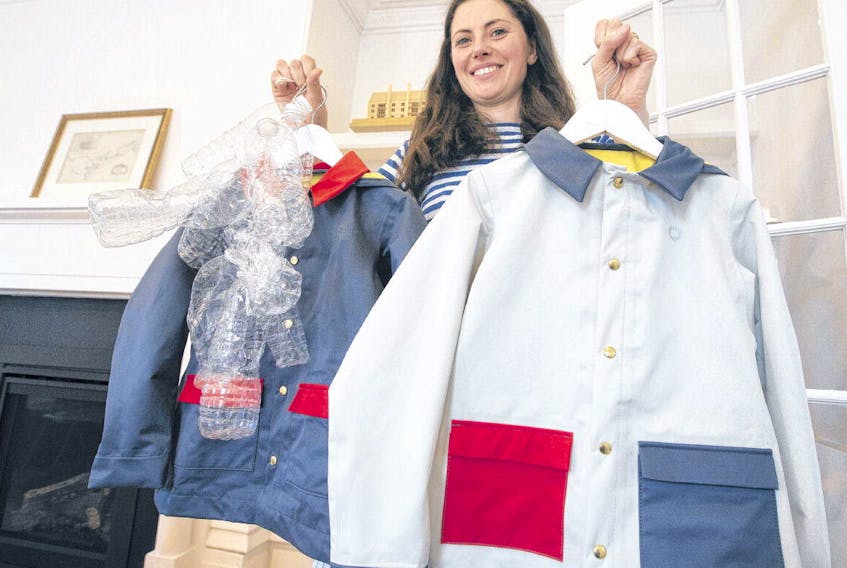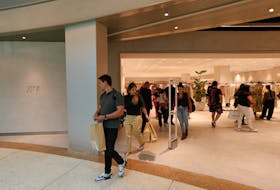Faire Child Makewear is the first company in Canada to make recyclable clothing.
The brainchild of Nova Scotia designer Tabitha Osler, the small company manufactures children’s raincoats, splash pants, coveralls, caps and backpacks out of Sympatex, a recyclable German fabric derived from plastic bottles.
“It takes 19 plastic bottles for one coat,” says Osler, holding up an adorable, multi-coloured kids’ raincoat next to a bunch of clear plastic bottles at her Dartmouth office. “We are the first company in Canada to use Sympatex.”
This chemical-free fabric, constructed out of three layers, is extremely light and very soft to the touch. “It’s an exquisite fabric,” says Osler. “It’s the only fabric fully recyclable, it’s breathable, waterproof, washable and dirt resistant.”
It’s also very expensive, at $23 a metre, so a raincoat costs $138. However, Osler says her durable “weatherwear” with heat-sealed seams can be worn year-round with layers, and her coveralls are a great alternative to the traditional, puffy, limb-immobilizing snowsuits.
Faire Child is based in a lightfilled, renovated, King Street house of shared offices, where Osler andthree employees have an office with four computers for marketing and selling online.
The clothes, made by Climate Technical Gear in Burnside, are shipped to online buyers in compostable packaging with labels made from sugar cane.
Millennials committed to sustainable living are willing to pay a price for a product that reduces waste and doesn’t become waste, says Osler.
Through Faire Child’s Take Back Program, purchasers mail in their garments for recycling right down to the brass snaps and receive a 15-per-cent discount on the next purchase.
Osler, a graduate in fashion from the Royal Academy of Fine Arts Antwerp, is inspired by the Cradle to Cradle design and manufacturing philosophy.
“When I went to the Royal Antwerp Academy, every collection I made pivoted on natural disasters, a forest fire or being pushed out of urban environments due to climate change, or changing migration patterns of birds. I wanted to make a product that had a positive impact on the environment.”
She was working at Toronto designer Lida Baday’s fashion house when the company closed. “They had mountains and mountains of fabric left over and are slowly selling it.
“The fashion industry produces waste that ends up in the landfills of developing countries.
Recently, countries like China have been rejecting North American textile waste.”
Osler was also inspired to start Faire Child when she became a mother to her daughter Charli, now two-and a-half years old. “I wanted children to see that waste could actually be a resource.”
She calls her clothing weatherwear, a heritage term for foulweather gear. “I wanted children to be able to weather the world. No matter what the weather, they’re able to get out in
it and play.”
Osler found her design inspiration in heirloom workwear from 1920s French hunting jackets to 1950s U.S. workmen’s coveralls. She visited the Vintage Showroom store in London, England, and borrowed pieces to copy their patterns. “I had to shrink it to mini-size and adapt it for kids. I ended up with these amazing details,” she says, pointing out the rain jacket’s underarm gusset that allows kids to lift their arms without their coat flying up, too.
“Heritage workwear was built to work in, for the body to move and for the garment to last.”
Osler took a 10-month CEED (Centre for Entrepreneurship Education & Development) program and ran a successful Kickstarter campaign to get Faire Child off the ground.
She received $30,000 from private investors through the Nova Scotia Equity Tax Credit program, money for innovation through the National Research Council-Industrial Research Assistance Program, and government investment through ACOA and the provincial Creative Industries Fund.
She has invested $10,000 herself and has takenno salary, surviving financially through teaching at NSCAD University. “For cash flow, I’m getting
a loan through Futurpreneur Canada,” she adds.
There have been two big challenges. Making the product and packaging recyclable and compostable down to every single detail “and having to learn to be a bookkeeper and a lawyer and an accountant,” says Osler.
In a year’s time she will expand to adult clothing, with an eye to sailors and outdoors people of all types.
For now, her target market is comprised of affluent parents age 25 to 45 living in urban centres and interested in sustainable fashion. They want their kids to get away from the screen and outdoors to learn to love and care about nature.
Faire Child is selling garments for kids age three to 10 but looking at making coveralls — great for puddle-jumpers — for toddlers under three.
Because Faire Child needs to sell its luxury sportswear at an accessible price, there is no physical store. This makes it difficult to market to people who like to touch and try on clothes before buying. “That is the disadvantage of e-commerce,” says Osler.
Last weekend people were amazed by the fabric’s light weight and softness at the Halifax Crafters spring market, where Faire Child sold $1,000 worth, “which was exciting.”
Osler plans pop-ups with one this Saturday at Sattva Boutique and May 19 at Lost & Found Art Vintage Kitsch, both on Agricola Street.
She is focusing on the Canadian market now, next year the U.S., and the year after Europe as well as looking this summer at New Zealand and Australia when it's winter.
In the fall Faire Child will travel to Montreal, Toronto and Vancouver for pop-ups. Also in the fall Osler hopes to rent “a small footprint” in a local store “as a touchand- feel point so customers can look at the product and actually try it on.”
~The Chronicle Herald









